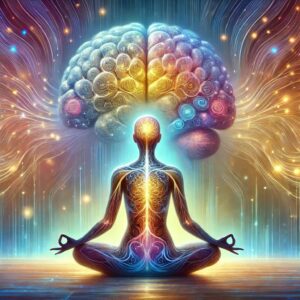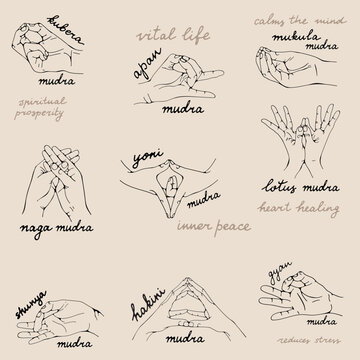मुद्रा
mūdrā
For millennia, ancient Vedic traditions have harnessed the power of mudrāḥ—sacred hand gestures—believing they could influence energy flow, promote well-being, and foster spiritual connection. What ancient rishis knew intuitively was validated for us personally when we participated in multiple 5-MEO-DMT ceremonies. Individuals who were not yoga practitioners or into mudras were spontaneously and without later recollection, embodying mudras spontaneously. We advise these people, after observing them, to meditate while holding those mudras as a form of integration practice. Mudrāḥ are now being studied for their profound effects on physiology, neurology, and even bioelectric energy.
I want to give a brief linguistic lesson: “mudra” is feminine (some language attribute feminine/masculine to their words!), and its plural form in Sanskrit is मुद्राः (mudrāḥ). In English, “mudras” is often used as the plural form, following the rules of English grammar. I’m going to use the Sanskrit plural form in this article, just to see if we can reprogram our language center. I “wrote” this article by asking A.i. questions and asking it to generate images. I wanted to research the scientific connections between something I know to be true and what knowledge is already out in the noosphere. Anyways, I feel the need to disclose my A.I. assistant for the sake of the Yamas of Yoga .
The Hands as Microcosms of the Body
In ancient Ayurvedic and Traditional Chinese Medicine, the hands are seen as maps of the body. Each finger and section of the hand corresponds to specific organs, energy centers, or bodily functions. This “microcosm” theory is the basis of reflexology and acupressure, where stimulating points on the hands or feet is believed to affect the entire body.
In yoga, this idea extends further. The hands are seen as channels for prana, or life force energy. Mudrah act as circuits, redirecting this energy to various chakras or energy centers in the body. This practice isn’t purely spiritual—modern neurology reveals that the hands are densely packed with nerve endings. When we hold specific hand positions, these nerves send signals to the brain, activating pathways that can influence emotions, thoughts, and even physical health.
Mudrah, Electromagnetic Fields, and Cognitive Connection
 The body generates an electromagnetic field, measurable through tools like electrocardiograms (ECGs) and magnetoencephalograms (MEGs). The hands and fingers, with their dense networks of nerve endings and capillaries, are especially sensitive to electromagnetic changes. While studies directly linking mudrah to bioelectric signals are limited, there is evidence that specific hand gestures can influence energy flow. A fascinating parallel is Polarity Therapy, a healing practice where practitioners use their hands to balance the body’s electromagnetic field. Ancient yogis intuitively worked with these principles, using mudrah to channel energy (prana) and harmonize the body and mind.
The body generates an electromagnetic field, measurable through tools like electrocardiograms (ECGs) and magnetoencephalograms (MEGs). The hands and fingers, with their dense networks of nerve endings and capillaries, are especially sensitive to electromagnetic changes. While studies directly linking mudrah to bioelectric signals are limited, there is evidence that specific hand gestures can influence energy flow. A fascinating parallel is Polarity Therapy, a healing practice where practitioners use their hands to balance the body’s electromagnetic field. Ancient yogis intuitively worked with these principles, using mudrah to channel energy (prana) and harmonize the body and mind.
Modern neuroscience adds another layer to this understanding. Hand gestures are closely tied to cognition, emotion, and motor control. By holding specific finger positions, mudrah activate regions of the brain that regulate these functions. Studies show that mudrah can anchor attention, reduce stress, and promote relaxation—key benefits in mindfulness practices. For instance, the Silva Method employs finger positions as “anchors” to help individuals recall specific states of mind or memories. These gestures act like post-it notes for the brain, making it easier to return to calm, focused, or meditative states. In this way, mudrah serve as powerful tools, bridging ancient energy practices with modern cognitive science.
Neural Circuitry and Postural Alignment
 The repeated use of mudrāḥ does more than channel energy; it reshapes the very fabric of our neurological and physical systems. Research into neuroplasticity—the brain’s ability to adapt and reorganize itself—supports the idea that practicing mudrāḥ consistently can rewire neural pathways. These ancient hand gestures help establish healthier patterns of thought and behavior, promoting relaxation, focus, and emotional stability over time. By engaging the mind and body in deliberate positions, mudrāḥ serve as tools for creating lasting mental and emotional harmony.
The repeated use of mudrāḥ does more than channel energy; it reshapes the very fabric of our neurological and physical systems. Research into neuroplasticity—the brain’s ability to adapt and reorganize itself—supports the idea that practicing mudrāḥ consistently can rewire neural pathways. These ancient hand gestures help establish healthier patterns of thought and behavior, promoting relaxation, focus, and emotional stability over time. By engaging the mind and body in deliberate positions, mudrāḥ serve as tools for creating lasting mental and emotional harmony.
Beyond their impact on the mind, mudrāḥ are intimately connected to the body’s alignment. The hands, as part of interconnected muscle and fascial systems, directly influence the shoulders, neck, and spine. Subtle changes in hand positioning create shifts in these systems, improving posture and overall body mechanics. For example, the deep front arm line links the fingers to the pectoral muscles and the cervical spine, meaning adjustments in hand placement can activate or relax muscle chains that affect alignment.
Therapeutic practices like the Alexander Technique and the Feldenkrais Method emphasize this connection. These modalities use specific hand and arm positions to reduce tension and improve postural awareness. Similarly, occupational health and physical therapy studies show that incorrect hand positioning can lead to musculoskeletal disorders, while proper positioning can alleviate pain and enhance function.
The “fake it till you make it” philosophy finds strong support in this context. Studies confirm that improving posture not only relieves discomfort but also boosts mood, willpower, and emotional resilience. Engaging in mudrāḥ, which inherently involve deliberate and balanced hand positions, can encourage these postural improvements subtly and naturally. By aligning the body, these gestures not only facilitate better physical health but also reinforce the mental and emotional benefits derived from their practice.
In this way, mudrāḥ serve as a bridge between ancient wisdom and modern science, harmonizing mind, body, and spirit in profoundly interconnected ways.
Experiment, Scientist-Yogi!
Ancient rishis understood that mudrah could harmonize the mind, body, and spirit. Today, science is beginning to explain how: by stimulating nerve endings, influencing brain activity, and potentially affecting bioelectric signals. Yet, the ancient sages didn’t wait for validation. They experimented on themselves, using mudrah to achieve balance and enlightenment.
Incorporating mudrah into your meditation or daily life is a way to honor this timeless wisdom. You don’t need to wait for more studies—observe the effects on your own body and mind. After all, the most profound discoveries come not from labs, but from within.




Yoga is not just book knowledge. One must practice! You must have discipline and curiosity. Try it. “You like to experiment so much. Experiment on yourself!” -Yogananda.
